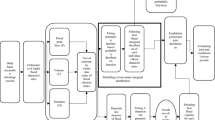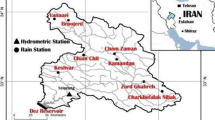Abstract
This paper introduces four kinds of novel bivariate maximum entropy distributions based on bivariate normal copula, Gumbel–Hougaard copula, Clayton copula and Frank copula. These joint distributions consist of two marginal univariate maximum entropy distributions. Four types of Poisson bivariate compound maximum entropy distributions are developed, based on the occurrence frequency of typhoons, on these novel bivariate maximum entropy distributions and on bivariate compound extreme value theory. Groups of disaster-induced typhoon processes since 1949–2001 in Qingdao area are selected, and the joint distribution of extreme water level and corresponding significant wave height in the same typhoon processes are established using the above Poisson bivariate compound maximum entropy distributions. The results show that all these four distributions are good enough to fit the original data. A novel grade of disaster-induced typhoon surges intensity is established based on the joint return period of extreme water level and corresponding significant wave height, and the disaster-induced typhoons in Qingdao verify this grade criterion.





Similar content being viewed by others
Abbreviations
- UMED:
-
Univariate maximum entropy distribution
- BMED:
-
Bivariate maximum entropy distributions
- NBMED:
-
Bivariate maximum entropy distributions with normal copula
- GHBMED:
-
Bivariate maximum entropy distributions with Gumbel–Hougaard copula
- CBMED:
-
Bivariate maximum entropy distributions with Clayton copula
- FBMED:
-
Bivariate maximum entropy distributions with Frank copula
- EBMED:
-
Equivalent bivariate maximum entropy distribution
- PBCEVD:
-
Poisson bivariate compound extreme value distribution
- PGMCD:
-
Poisson–Gumbel mixed compound distribution
- PBCMED:
-
Poisson bivariate compound maximum entropy distribution
- MOM:
-
Method of moments
- ECFM:
-
Empirical curve-fitting method
- MLM:
-
Maximum likelihood method
- PNBMED:
-
Poisson normal bivariate maximum entropy distribution
- PGHBMED:
-
Poisson Gumbel–Hougaard bivariate maximum entropy distribution
- PCBMED:
-
Poisson Clayton bivariate maximum entropy distribution
- PFBMED:
-
Poisson Frank bivariate maximum entropy distribution
References
Antão E (2012) Probabilistic models of sea wave steepness. PhD thesis on naval architecture and marine engineering, Instituto Superior Tecnico, Technical University of Lisbon
Athanassoulis GA, Skarsoulis EK, Belibassakis KA (1994) Bi-variate distributions with given marginals with an application to wave climate description. Appl Ocean Res 16(1):1–17
Bitner-Gregersen E, Guedes Soares C (1997) Overview of probabilistic models of the wave environment for reliability assessment of offshore structures. In: Guedes Soares C (ed) Advances in safety and reliability. Pergamon, Oxford, pp 1445–1456
De Waal DJ, van Gelder PHAJM (2005) Modelling of extreme wave heights and periods through copulas. Extremes 8:345–356
Dolan R, Davis RE (1994) Coastal storm hazards. J Coast Res Spec Issue 12:103–114
Dong S, Liu YK, Wei Y (2005) Combined return value estimation of wind speed and wave height with Poisson bi-variate lognormal distribution. In: Proceedings of the 15th international offshore and polar engineering conference, vol 3. ISOPE, Seoul, pp 435–439
Dong S, Xu PJ, Liu W (2009) Long-term prediction of return extreme storm surge elevation in Jiaozhou Bay. J Ocean Univ China 39(5):1119–1124
Dong S, Liu W, Zhang L, Guedes Soares C (2012a) Return value estimation of significant wave heights with maximum entropy distribution. J Offshore Mech Arct Eng. doi:10.1115/1.4023248
Dong S, Tao SS, Lei SH, Guedes Soares C (2012b) Parameter estimation of the maximum entropy distribution of significant wave height. J Coast Res. doi:10.2112/JCOASTRES-D-11-00185.1
Dong S, Wang N, Liu W, Guedes Soares C (2013) Bivariate maximum entropy distribution of significant wave height and peak period. Ocean Eng 59:86–99
Favre AC, Adlouni SE, Perreault L, Thiémonge N, Bobée B (2004) Multivariate hydrological frequency analysis using Copulas. Water Resour Res 40(1):1–12
Feller W (1957) An introduction to probability theory and its applications, 2nd edn. Wiley, New York
Ferreira JA, Guedes Soares C (2002) Modeling bivariate distributions of significant wave height and mean wave period. Appl Ocean Res 24(1):31–45
Guedes Soares C, Scotto MG (2001) Modelling uncertainty in long-term predictions of significant wave height. Ocean Eng 28(3):329–342
Guedes Soares C, Scotto MG (2011) Long term and extreme value models of wave data. In: Guedes Soares C, Garbatov Y, Fonseca N, Teixeira AP (eds) Marine technology and engineering. Taylor & Francis, UK, pp 97–108
Guo KC, Guo MK, Jiang CB et al (1998) Preliminary analysis of disaster caused by typhoon no. 9711 in Shandong Peninsula of China. Marine Forecast 15(2):47–51 (in Chinese)
Halsey SD (1986) Proposed classification scale for major Northeast storms: East Coast USA, based on extent of damage. Geol Soc Am Abstr Program (Northeast Sect) 18:21
Hanne TW, Dag M, Havard R (2004) Statistical properties of successive wave heights and successive wave periods. Appl Ocean Res 26(3–4):114–136
Haver S (1985) Wave climate off northern Norway. Appl Ocean Res 7(2):85–92
Hu L (2002) Essays in econometrics with applications in macroeconomic and financial modeling. Yale University, New Haven
Isaacson M, MacKenzie NG (1981) Long-term distributions of ocean waves: a review. J Waterw Port Coast Ocean Div 107(2):93–109
Jaynes ET (1968) Prior probability. IEEE Trans Syst Sci Cybern 4:227–241
Jonathan P, Flynn J, Ewans KC (2010) Joint modelling of wave spectral parameters for extreme sea states. Ocean Eng 37:1070–1080
Leira BJ (2010) A comparison of some multivariate Weibull distributions. In: Proceedings of the ASME 2010 29th international conference on ocean, offshore and arctic engineering, OMAE2010-20678, June 6–11, 2010, Shanghai, China
Li PS (1998) Study on typhoon storm surge disaster forecasting in Qingdao area. Marine Forecast 15(3):72–78 (in Chinese)
Liu DF, Wen SQ, Wang LP (2002) Poisson–Gumbel Mixed compound distribution and its application. Chin Sci Bull 47(22):1901–1906
Liu W, Dong S, Chu XJ (2010) Study on joint return period of wind speed and wave height considering lifetime of platform structure. In: Proceedings of the 29th international conference on offshore mechanics and polar engineering, Shanghai, China, OMAE20247, vol 2, pp 245–250
Ma FS, Liu DF (1979) Compound extreme distribution theory and its applications. Acta Math Appl Sin 2(4):366–375
Mendoza ET, Jiménez JA (2005) A storm classification based on the beach erosion potential in the Catalonian Coast. Coast Dyn 2005, 1–11. doi:10.1061/40855(214)98
Morton ID, Bowers J (1996) Extreme value analysis in a multivariate offshore environment. Appl Ocean Res 18:303–317
Muhaisen OSH, Elramlawee NJE, García PA (2010) Copula-EVT-based simulation for optimal rubble-mound breakwater design. Civil Eng Environ Syst 27(4):315–328
Muir LR, El-Shaarawi AH (1986) On the calculation of extreme wave heights: a review. Ocean Eng 13(1):93–118
Nelsen RB (2006) An introduction to copulas. Springer, New York
Nerzic R, Prevosto M (2000) Modeling of wind and wave joint occurrence probability and persistence duration from satellite observation data. In: Proceedings of the tenth international offshore and polar engineering conference, vol 3, May 28–June 2, 2000, Seattle, USA, pp 154–158
Petrov V, Guedes Soares C, Gotovac H (2013) Prediction of extreme significant wave heights using maximum entropy. Coast Eng 74:1–10
Prince-Wright R (1995) Maximum likelihood models of joint environmental data for TLP design. In: Proceedings of the 14th international conference on offshore mechanics and arctic engineering (OMAE 1995), vol 2. ASME, NY
Repko A, Van Gelder PHAJM, Voortman HG, Vrijling JK (2004) Bivariate description of offshore wave conditions with physics-based extreme value statistics. Appl Ocean Res 26:162–170
Sklar A (1959) Fonctions de répartition à n dimensions et leurs marges. Publ Inst State Univ Paris 8:229–231
Van Vledder G, Goda Y, Hawkes P, Mansard E, Martin MJ, Mathiesen M, Peltier E, Thompson E (1993) Case studies of extreme wave analysis: a comparative analysis. In: Proceedings of the second international symposium on ocean wave measurement and analysis, pp 978–992
Wahl T, Mudersbach C, Jensen J (2012) Assessing the hydrodynamic boundary conditions for risk analyses in coastal areas: a multivariate statistical approach based on copula functions. Nat Hazards Earth Syst Sci 12:495–510
Zachary S, Feld G, Ward G, Wolfram J (1998) Multivariate extrapolation in the offshore environment. Appl Ocean Res 20(5):273–295
Zhang LZ, Xu DL (2005) A new maximum entropy probability function for the surface elevation of nonlinear sea waves. China Ocean Eng 19(4):637–646
Acknowledgments
The study was partially supported by the National Natural Science Foundation of China (51279186), the National Program on Key Basic Research Project (2011CB013704) and the Program for New Century Excellent Talents in University (NCET-07-0778).
Author information
Authors and Affiliations
Corresponding author
Appendix
Appendix
The distribution function of Gumbel distribution is
in which μ and σ are the location parameter and scale parameter, respectively.
The distribution function of Weibull distribution is
in which μ > 0 is the location parameter, σ > 0 is the shape parameter, γ > 0 is the scale parameter.
The distribution function of lognormal distribution is
in which μ and σ are the location parameter and scale parameter, respectively.
Rights and permissions
About this article
Cite this article
Tao, S., Dong, S., Wang, N. et al. Estimating storm surge intensity with Poisson bivariate maximum entropy distributions based on copulas. Nat Hazards 68, 791–807 (2013). https://doi.org/10.1007/s11069-013-0654-6
Received:
Accepted:
Published:
Issue Date:
DOI: https://doi.org/10.1007/s11069-013-0654-6




